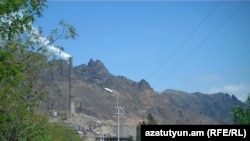A research center of the state-funded academy released this week the results of a year-long study of fruit and vegetables grown around several local towns and villages. According to them, all of these crops were found to be dangerously rich in toxic heavy metals such as copper, mercury and lead.
The study commissioned by the Yerevan office of the Organization for Security and Cooperation in Europe blames that on irrigation water from the River Debed that flows through the region bordering Georgia. It says the river was in turn contaminated by two nearby metallurgical enterprises.
Both companies mine copper and other non-ferrous metals and have ore-processing facilities close to the Debed. One of them, the Lichtenstein-registered Armenian Copper Program, also operates a Soviet-era copper smelter in Alaverdi, Lori’s second largest town.
The plant, which is Alaverdi’s main employer, has for decades been notorious for its toxic emissions which Armenian environmentalists and some medics say are responsible for the higher-than-average incidence of some serious diseases in the area.
According to Anush Evoyan, who coordinates an OSCE project in Alaverdi, locally grown agricultural products are dangerous for consumption even if their precise impact on public health has not yet been researched in detail.
“They are consumed not only by their producers but also reach the local market and become a risk factor for the population,” Evoyan told RFE/RL’s Armenian service.
The authors of the OSCE-funded study believe that local farmers should not cultivate their land until it is cleaned of toxic metals.
This is hardly an appealing prospect for the mostly low-income villagers, who seem to be aware of the health risks but continue to grow their crops. As things stand now, they would have trouble finding an alternative source of income.





